| |

|
|
|
|
||
Lamborghini Diablo Car Repairs
This page contains a list of simple repairs users have made to their Diablo cars.
Please note, if you carry out any of the "repairs" described here, your car you are doing so at your own risk. I take no responsibility what so ever for the information and suggestions supplied. In particular if you do not understand or have experience working on expensive cars like these, save yourself time and money by bringing it to a dealer or garage that has.
| Repair Topic (Click on Item) | Picture | Description |
| Removing a Diablo rear bumper |
.jpg) |
From a posted by "Placid" (in Scandinavia) at LamboPower.com |
| Replacing Diablo Belts |
 |
This explains how to remove the two engine belts of a Diabllo. |
| Replacing Diablo Door Struts |
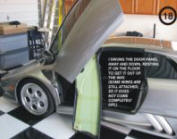 |
This is a series of pictures illustrating how to replace the door struts in a Diablo |
| Refurbishing the engine and clutch of a 1993 Diablo |
 |
Removing the
engine from a Diablo is quite a complex task. This is already written up
once on this web site. See
here.
However everybody has a slightly different way of doing it. This write-up is really a series of photographs showing in detail many important steps in the process and describes in great detail how an engine should be refurbished. |
|
Installing an Alpine NAV System in a 1999 Diablo |
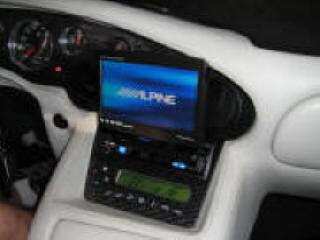 |
For those that wish to "do it yourself" Rick Warwick has submitted this account of installing an Alpine NAV system in a '99 Diablo. He installed a system consisting of an Alpine IVA-D310 flip up
LCD, an |
 |
The connecting rod that connects the hydraulic clutch slave cylinder to the clutch lever is a weak point in Diablos from 1995 onwards. Many brakes have been reported. Failure is immediate and with no warning. There is a sudden loss of clutch control. Further, if you continue to pump the clutch pedal, you will push the broken rod out of the cylinder dumping it on the road. The cylinder piston comes out of the cylinder and brake oil leaks out with each pump. A better solution is illustrated here. | |
|
Replacing the Tachometer Dash Light
|
 |
From time to time the dash lights can burn out in Lamborghinis as in all cars. (Unfortunately LEDs are slow to be adapted by the industry). Fortunately replacing them in Lamborghinis is often fairly easy. |
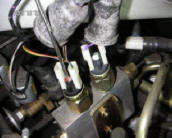 |
All Lamborghini Diablos (after 1993), the Murciélago and from 2005 onwards Gallardo's have a system that allows the driver to raise the front of the car about 2 inches (when driving at low speeds) to get over obstructions on the road or driveway. Unfortunately this system is a notoriously badly designed system. It is perhaps the greatest failure in the design of Lamborghini cars and is the subject of numerous discussions in Web forum discussion groups. The major problem with this system is that the front Koni shocks (through which oil is pumped into to rise the car) leak. There are particularly prone to do so if they are "bumped" when the car is in the raised condition. The oil pressure system puts out over 1500 PSI to raise the car. The seals in the shocks simply are not designed to take this pressure. Also there are sensitive oil pressure switches that monitor the system. These switches sometimes fail as well. | |
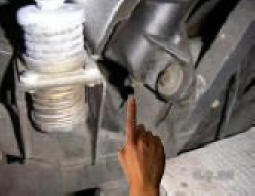 |
Every two years at least you should change the coolant in your car. Wet cold winter days when you cannot drive is a good time to do this. Unfortunately in a Diablo changing the coolant is not as easy as in most cars. The reason for this is that the stopcock is very difficult to find and open. It is quite common to have it snap off in the process. Some people resort to draining the radiator by disconnecting one of the hoses instead. I describe here a fix in which we will replace the Lamborghini hard to open spigot with an easily accessible stopcock. | |
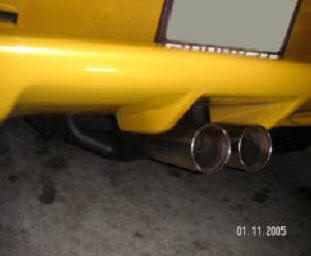 |
There are a number of times when one may wish to remove the muffler from a Lamborghini. Almost any major engine repair for example will require the muffler to be removed. Fortunately this is relatively easy to do in most of the cars. I will illustrate it here with a Diablo. I will also outline how to go about repairing the muffler box if one of the catalyst attachment bolts gets broken. This is common on older (often rusted) cars. | |
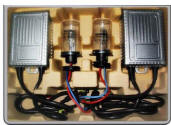 |
The headlights of Diablo and earlier cars leave much to be desired in terms of lighting intensity. Poor lighting often becomes the limiting factor for high speed night driving in these cars. These days there are a number of aftermarket kits available to allow you to add your own Xenon high intensity lighting display (HID) to your car. What is needed is to replace the low beam light with HID lights. It is not necessary to replace the high beam lights since the low beam lamps remain on with the high beam. On 1999 and later Diablos the lights are actually Nissan 300ZX units. This makes it easy to find a replacement HID unit. | |
|
Changing the Oil in a Diablo |
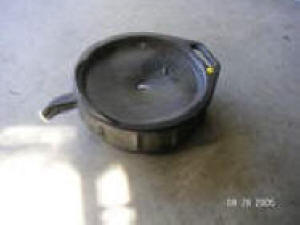 |
Frequent oil changes are one of the best things you can do to extend the life of any engine. If you start and stop the car often this requirement is even more critical. Fortunately changing the oil in these cars is simple to do. I will describe how to do it for a 6L Diablo. The process is essentially the same for other Lamborghini cars. I hope the more experienced readers will forgive me, but I am going to explain this process in very simple steps for people that may not take on the more challenging "repairs" I have in other parts of this site but might tackle a simple task like this. |
|
Changing Brake Fluid Oil in a Diablo |
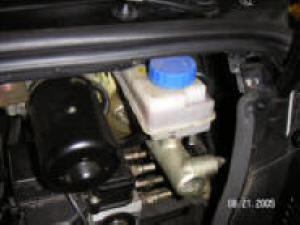 |
In all Lamborghinis the brake fluid should to be changed every 5,000 to 10,000 miles. This number will change depending on how hard you drive and use the brakes. The friction on the brake shoes on these heavy cars is tremendous. The brakes quickly get very hot and can lead to severe burns if touched. Likewise the oil driving the cylinders in the brake shoes gets hot. Over time it starts to char and go brown or black. If unchanged it will cause buildup of deposits in the lines leading to poor brake performance. Fortunately a brake fluid change can be done at any good brake shop or if you have the time and knowledge done yourself. |
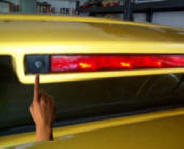 |
This is an easy one! At the 2004 Annual Concorso Italiano Car Show was held again in Monterey California, I did a quick survey of how many Diablos had a crack in one or both sides of the plastic light holder for the rear central brake light. Surprisingly many had a crack. This is due to the nut being tightened too tight to the frame of the car. It seems that the plastic material that makes up this light is very fragile at this location. If it is not taken care of it will shake loose and possibly be lost. | |
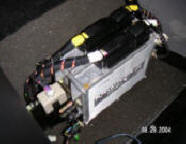 |
The LIE computer on Diablos (and all
later cars) accumulate a detailed
history of numerous measurements of a
cars performance over time. Things like
the max RPM's the car has experienced.
The max temperature of oil, water etc.
It also contains a detailed list of
engine code errors. Even if the check
engine light goes out the code is still
retained in the LIE computers memory for
about 400 ignition key on/off cycles. If you have overhauled the engine or corrected some other engine problem some people like to clear out these error codes. Start with a clean slate so to speak. This can be done using a jumper socket to the LIE computer. |
|
|
|
The throttle position sensor (or TPS as
it is called), is nothing more than a
potentiometer where over a gradient
range from 0 to +5V a moveable arm reads
out the position of the engine throttle
lever. It appears to be the same unit in
all Diablo cars. I do not know about the
more recent cars. The sensor is connected to the engine throttle control by two screws. These screws can loosen causing the engine to have a high RPM on idle and/or have the carter motor remain on after the ignition is switched off. The latter will run down the battery overnight. Alternatively the TPS itself can ware out giving back unreliable information about the engine throttle control to the LIE computer. Fortunately checking and adjusting this sensor is simple. |
|
|
|
One of the often overlooked features when it comes to detecting engine faults with later Lamborghini engines is the fact that they are really two engines in one. The front "Check Engine Lights" have a (L) Left and (R) Right lamp. This not only means that if there is a localized fault with the engine you can determine on which bank of cylinders it resides on, but you can further localize the fault by switching components from one side to the next. | |
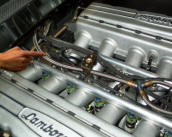 |
The "Carter Motor" is a servo motor that
sits on top of the engine and adjusts
the throttle when the engine is cold. It
is controlled by a separate controller
unit that is situated beside the LIE
computer (but is not part of it). The
reason it is called a "Carter Motor" is
that it is a servo motor made by a large
manufacture of server motors called
"Carter". The operating strategy of this device is co-related to the time that passes from engine ignition and the different temperatures picked up by the engine control sensors. The carter motor uses these parameters to bring the accelerator opening to a calculated value. This decreases as time passes, and the accelerator control is released when the engine reaches the correct rpm. If this motor fails, you will get a "L-check engine " light, an OBDII reading "Random Misfire" as well as difficulties keeping the engine turning over at low RPM's when it is cold. |
|
|
|
The LIE computer system in Diablo and
later cars is a state of the art system
for getting the maximum power out of the
engine. It has a very sophisticated
system of diagnostic tests that run in
real time to check that the engine is
running properly. Even minor out of
specs changes in engine performance are
flagged to the driver in the form of the
Left or Right "Check Engine" light. The LIE computer has a number of sensors to determine how your engine is running. One, is a set of sensors called "Engine Misfire" sensors. These sensors are located on the left and right sides of the engine. They should be checked periodically to make sure the hose connection to them is not leaking. |
|
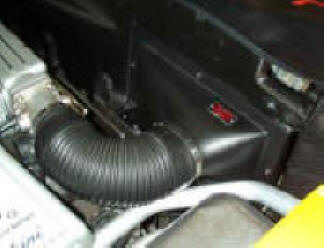 |
Probably no other single maintenance change to an engine has a greater effect on an engine than changing a dirty air filter. Lamborghini engines suck in a lot of air! If this air flow is impeded with a clogged filter performance suffers greatly. Fortunately Lamborghini has designed their cars so that replacing an air filter is simple to do. | |
|
|
A very common complaint from Diablo drivers is that the seat is too narrow. This is particularly so for the recent 6.0L models. In these cars the seat and seat back are separate allowing one to be adjusted independently of the other. This is a long overdue requirement. However for many of us these seats are actually more uncomfortable than those of the earlier one piece molded early models because the actual sitting area within the seat is too narrow. One needs to widen the horizontal area for your butt! This can be done but it does require a stomach to distort the seat structure. | |
|
|
A very common problem on Diablo's is that the handbrake "on light" on the dash does not always go off when you release the handbrake. This can often be corrected by raising the hand brake bar even tighter and then releasing it. The bad news is that this gets worse with time. It got to the point with mine that eventually it would not go our at all. Fortunately it is not hard to permanently correct this problem. | |
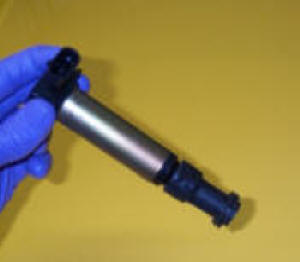 |
Each spark plug in a 6.0L Diablo has its
own ignition coil directly on top of the
plug itself. This arrangement known as
"Coil On Plug" or COP allows for a very
efficient control of engine timing. A
low 12v lead goes to each COP where it
goes to an induction coil. The secondary
coil lead goes directly to the plug
socket. Because there are no high
voltage leads going along the engine top
to each coil higher voltages and sparks
can be obtained. The only problem is that sometimes these coils short out. They are buried deep within the engine (see below). Normal coil testers will not work because the probe cannot be placed along side the actual coil. |
|
|
|
Each wheel of a Diablo (and I assume
later cars) has an internal sensor that
continuously tracks the air pressure in
the tire. Should it drop below about 28
PSI it will alarm the driver by
switching on the "Tire Pressure
Indicator" light on the dash. The system
is very useful. Lamborghini was way
ahead of its time in providing such a
system. What is even more remarkable is
that the sensors themselves do not need
internal batteries. Instead they contain
a magnet and coil that generates enough
current when the tire rotates to drive
the sensor. The only problem is that if you get a flat and have to temporally fill the tire with inflation foam the inflation rubber like "gunk" inactivates the sensor. A simple procedure to remove the sensor and clean it is provided here. |
|
|
|
Fuel injectors play a critical role in delivering the high performance standards to the engines of these cars. Unfortunately they have a history of failing. The good news is that you can quickly do a few simple tests to identify a faulty injector. The Left or Right "Check Engine Light" is usually your first indication that something is wrong. The tests here then will help you identify the faulty candidate(s). | |
|
|
The two door handles in the Diablo suffer numerous scratches over time due to the fact that they are made from a soft plastic material. Fortunately replacing them is simple and not expensive (by Lamborghini standards). | |
 |
The two air sensors on a Diablo can fail
from time to time. This will fire up the left or right check engine
light. Fortunately replacing them is easy and not too expensive. An Air Sensor is shown here on the left. It is a simple device containing a small red bead connected to two wires which I assume changes its electrical conductivity depending on the oxygen content of the air. |
|
 |
Removing an engine from a Diablo is quite a complex task. There are a number of times you may need to remove the engine from the car. The most common is when you need to change the clutch. I will present at a later date information as to how to do that . Right now lets concentrate on just getting the engine out. You will need a few specialized tools and at least one other person to help you. The engine itself weighs almost 1 ton, so a way to mechanically hoist it out of the car is essential. | |
 |
While not strictly a repair, I have had a few
people ask me on this web site , is it possible to change the battery on a
Lamborghini Diablo VT 98 or later radio security door key. The answer is yes
but it is a bit tricky. Click
below to find out how. Related: This Security radio has a number of options that are not mentioned in the car manual. The key is made by an Italian company called Med. Click on to read an English translation of Med.pdf. This describes how to program the key. Note the page numbers in the .pdf file are not in order. |
|
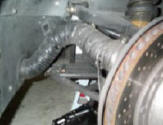 |
While checking my VT recently I noticed that the left front air duct to the disk brake had a brake in it. This duct takes air from the front of the car and redirects it over the front disk brake rotors. This helps to insure that the rotors keep cool when braking at high speeds. Because the front wheels move so much relative to the rest of the car, part of the duct work consists of a flexible hose. This hose is almost 3 inches in diameter. It is made of a flexible material that also contains a spiral metal spring like support. Over time it appears the flexible material fatigues and shows brakes. This allows the air to escape leading to less cooling of the brake rotors. Fortunately replacement is simple and well worth the effort. | |
 |
Recently I noticed my rear brake lights
were not coming on when I pressed the
brake pedal. Needless to say this is a
very dangerous situation in a Diablo
with drivers always following you behind
and trying to keep up. It turns out the
contact brake switch pressing against
the brake pedal arm was at fault. This report shows how to replace this brake pedal switch with a common US generic one. |
|
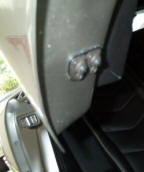 |
I live by the sea in the San Francisco
Bay area. One of the best places in the
world to live! One little problem
however. The air has minute traces of
salt in it. When it rains here this salt
can work its way into the car if it gets
wet. I noticed recently that the red light on the side of one door that comes on when the door is opened was intermittent. Sometimes it came on other times it did not. The culprit turned out to be minor corrosion on the door open/closed contact switch. The switch unit (there are two switches in the unit) is on the front side surface of the door. It needed to be disassembled and cleaned. |
|
| Window Worm Screw Adjustment |
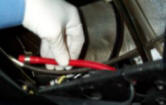 |
Recently something inside my car door
started to rattle when I ran the car
above about 70 MPH. Even more scary was
the fact I heard a strange sound when I
raised or lowered the window. This report shows how to open up the door interior and correct a simple problem where the red rubber sleeve covering the long flexible window worm screw that is used to raise and lower the window came off. |
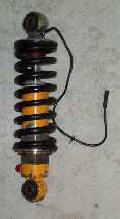 |
Recently there has been a lot of
discussion amongst Diablo owners about a
problem with the Koni shocks in 1997 and
later Diablo's. The problem with these
cars is that the front shocks often fail
(leak oil) if the car hits a major bump
in the road. It appears to be a design
problem related to the fact that these
cars have a mechanism that allows the
driver to pump oil from the power
steering into the shocks that raises the
car about 4 inches. A very nice feature
when going over bumps in the road or
driving up a slope. |
|
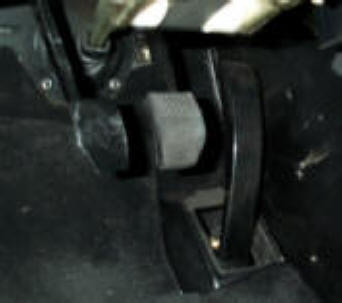 |
A common complaint for drivers of Diablo's (and perhaps other Lamborghini cars) is that the brake and clutch pedals are too small and too close together. If one happens to be in stop and go traffic for any period of time ones left foot can really gets sore pressing of the small pedal. The solution involves attaching a larger "After Market" pedal plate. However things are complicated by the fact that the surface of the Lamborghini pedals are very curved making attachment difficult. A solution is presented here. Also a much improved left dead foot pedal is added to the car. | |
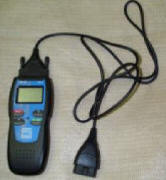 |
Just like any other North American car made after 1996 the Diablo has an "OBDII socket" for a OBDII scan tool. Government mandated rules specify that after the check engine warning light comes on due to a fault, the engine control unit must record a specific error code. The purpose of this code is to give precise information to the service technician concerning the fault to allow its repair. | |
|
Side Mirror Changes For A Diablo |
|
One problem we all have driving
Countach's and Diablo's is that
visibility to the rear of the car is
poor. The side mirrors on these cars are
too small and provide only a limited
field of view. To make matter worse,
when other people on the road are
driving alongside to view the car, they
tend to hang back at 4 and 7 o'clock
positions, exactly the blind spot for
these mirrors! The solution: use a
convex mirror. The problem is that
Lamborghini does not provide these
mirrors. At least not in the US. The solution is simple. Go out and find a large convex mirror of the type used in pickup trucks and have a glass shop cut out a mirror from these mirrors exactly the shape and size of the one in your car. Then simply glue this mirror on to the surface of the current (flat) Lamborghini mirror. The resulting field of view as seen from the drivers seat is simply a night and day difference. No longer can drivers in the right lane sneak up on you. The photograph on the left shows such a modified mirror. If you live in the San Francisco bay area you can have this done by Franks of Berkley at (510)548-1434 They do great work and are very reasonable price wise. |
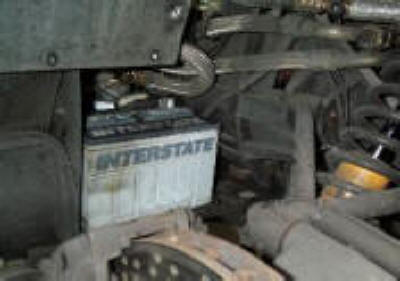 |
The 450+ HP engine of a Diablo is
requires a good battery to crank the
car. It is quite common in a failing
battery to still have strong lights,
radio etc. and yet the battery cannot
even the starter. A good battery is
essential Replacing a Diablo battery is not as simple as replacing the battery on your typical US car. This is because Lamborghini placed the battery low to the ground in front of the left rear wheel in a Diablo. |
|
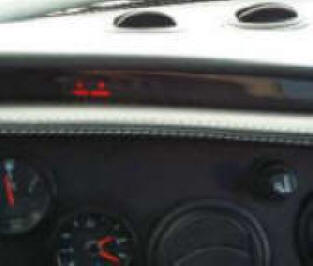 |
The engine of a Diablo is a marvel of
engineering and really a work of art.
The engine is really two 6 cylinder
engines joined side by side and
controlled by two separate computer
systems. Diablo engines are very
reliable. They can take a tremendous
pounding and are for most of us driven
far below their capabilities in terms of
power demands. Nevertheless from time to time things can go wrong or need a minor adjustment. The computer signals if something is wrong with the engine by turning on the R or L engine warning light. These two lights correspond to the right and left bank of cylinders of the V12 engine. Rather than acting as a simple warning light however, there is a diagnostic test to then find out what the problem is. |
|
|
|
Diablo's are heavy cars weighing almost two tons. This weight puts considerable strain on the six shock absorbers of the car. The softness of the absorbers can be adjusted by the driver over 4 settings. One being most soft, four being like there is no shock at all. There is also an "auto" setting which allows the cars computer to match the settings with road conditions and speed. Should any one absorber fail an error light will come on indicating there is a problem. Fortunately Lamborghini has installed in the car a computer driven series of tests to locate which wheel is at fault. | |
 |
While not strictly a repair topic, this seems an appropriate place describe how and where to put a radar detector in a Diablo. Many suggestions have been made as to the best location for a detector. Clearly the simplest is to place it front and center on the windscreen using the suction cups supplied by the manufacture. While this is very simple to do there are disadvantages. The unit is very visible, asking to get stolen and the power wire going to the cigarette lighter socket looks ugly. The approach here is to place the detector between the roof and the passenger side sun shade running the power cord between the roof and roof padding. The LED display from the detector is also relocated to the roof dome light fixture. | |
|
|
A fairly common problem in later Diablo's is the horn button no longer works. The reason for this has to do with the design of these buttons. There are two buttons underneath the leather on the steering wheel. They consist of two pieces of brass separated by rubber disks. When the horn is pressed, the rubber between the brass plates is compressed and the two brass disks make contact closing an electrical connection. The horn fails when the rubber gets hardened and does not give enough to let the brass plates to come together. Lamborghini's solution is to supply the customer with a new steering wheel. | |